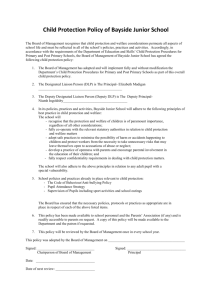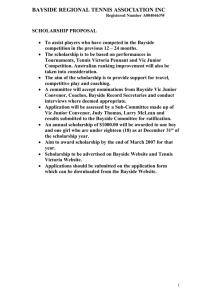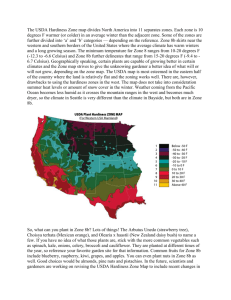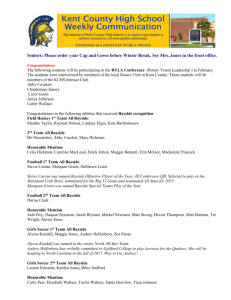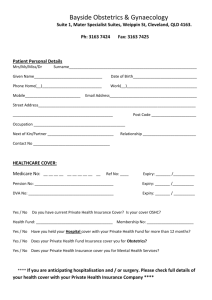Council Plan - Bayside City Council
advertisement
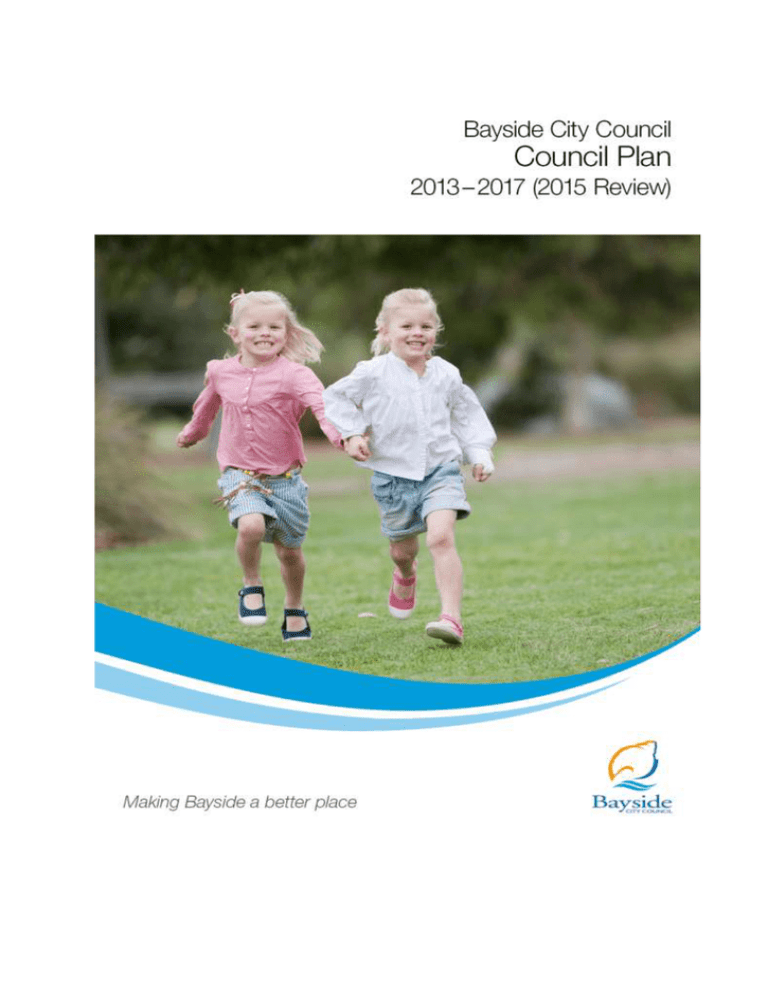
COUNCIL PLAN REVIEW (2015) April 28, 2015 Table of Contents Making Bayside a Better Place .............................................................................................. 3 Overview of Bayside - Our Community .................................................................................. 3 Overview of Bayside - Our Council ................................................................................. 5 Councillor Profile ............................................................................................................. 5 Council meetings, special committees and networks ............................................................ 6 Audit Committee .............................................................................................................. 6 Risk Management ........................................................................................................... 7 Code of Conduct ............................................................................................................. 7 Overview of Bayside - Our Planning Framework ................................................................... 8 Community Plan .............................................................................................................. 9 Council Plan .................................................................................................................... 9 Annual Budget............................................................................................................... 10 The Better Place Approach ........................................................................................... 10 Annual Department Plans and Staff Performance Plans ............................................... 10 Structure of Council Plan ..................................................................................................... 11 Goal 1 – An engaged community and Council .............................................................. 12 Goal 2 – A strong supportive community....................................................................... 13 Goal 3 – A liveable city .................................................................................................. 14 Goal 4 – A sustainable natural environment.................................................................. 16 Goal 5 – A creative and active community .................................................................... 18 Goal 6 – A thriving local economy ................................................................................. 20 Goal 7 – A finanically responsible Council with good governance ................................ 21 2 COUNCIL PLAN REVIEW (2015) April 28, 2015 Making Bayside a Better Place… Bayside City Council’s purpose is to work together with the community to ‘make Bayside a better place.’ In developing this new Council Plan, Council was guided by the Bayside 2020 Community Plan and our community’s vision for its future. The Council Plan details the strategic objectives that Council will pursue to achieve Bayside’s vision over the next four years. The Council Plan is resourced through the Annual Budget and progress toward achieving strategic objectives will be reported regularly to the community through the corporate reporting cycle including the Annual Report. The Council Plan will guide decision making, resource allocation, service provision and organisational focus for the next four years. Overview of Bayside - Our Community Bayside City Council was created on 15 December 1994. It comprises the former Cities of Brighton and Sandringham and parts of the former Cities of Mordialloc and Moorabbin. The area now known as Bayside was originally inhabited by the Boon wurrung people of the Kulin nation. The coastal land from Brighton to Mordialloc is the traditional country of the Ngaruk Willum clan of the Boon wurrung people. The City of Bayside covers an area of 37 square kilometres from Melbourne’s central business district. The coastline of Port Phillip Bay forms the western boundary of Bayside, while the Nepean Highway and the Melbourne to Frankston railway line form most of the eastern boundary. Baysides natural environment, from our 17 kilometre stretch of sparkling coastline to the urban forest of our streets, is an important asset to us all. Preservation and enhancement works are completed each year to help maintain our natural environment and protect it from the impact of development, increasing use and climate change. Council also works with many partners to educate our community and stakeholders through many initiatives and programs. Bayside is characterised by quality residential areas and a variety of businesses. Residents and visitors alike enjoy Bayside’s numerous parks, reserves, foreshore, local retail centres, sporting and recreational grounds, heritage buildings, art galleries and festivals. 3 COUNCIL PLAN REVIEW (2015) April 28, 2015 In 2013, the preliminary estimated resident population of the City was 98,368 persons. In the 10 years from 2003 to 2013, the population increased by 10.4% from 89,088 persons in 2003. The Bayside community is largely Australian-born (71 per cent). The main overseas countries of birth are the United Kingdom, New Zealand and South Africa. There are 155 persons in Bayside who identified themselves as indigenous.. Eight out of ten Bayside residents speak English at home (82 per cent). The main nonEnglish languages spoken at home are Greek, Italian and Russian. A total of 71 per cent of Bayside’s 34,700 households are family households. The dominant household types are couples with children, followed by mostly older couples without children. Lone person households (mostly older and middle-aged people) comprise of 23 per cent of all Bayside households. Consistent with the common household types in Bayside, the largest age groups in the community are 35 to 49 years and 50 to 59 years. Since 2006, there has been an increase in the number of empty nesters and retirees, primary school age children and older workers and a decrease in the number of young adults aged 25 to 34. Over the past decade, Bayside has had a growing population of elderly residents aged 85 years and over. With an ageing population, Bayside is expected to have a four per cent increase in residents over the age of 70 years by the year 2031. Bayside is home to approximately 12,500 businesses which are a mix of local, national and international business, including 3 of Australia’s top 200 companies. The most common industry categories are professional, scientific and technical services, rental hiring and real estate services, financial and insurance services, construction, retail trade, health care and social assistance. Two-thirds (66 per cent) of Bayside’s employed residents travel outside the municipality to work – predominantly to the Cities of Melbourne, Kingston and Port Phillip – while 25 per cent of employed people in Bayside live and work in the area. 4 COUNCIL PLAN REVIEW (2015) April 28, 2015 Overview of Bayside - Our Council Councillor Profile Bayside residents elected seven councillor over three wards to govern our city. Northern Ward Cr Michael Heffernan Mobile 0400 965 233 Email mheffernan@bayside.vic.gov.au Cr Alex del Porto Mobile 0417 390 641 Email adelporto@bayside.vic.gov.au Central Ward Cr Bruce Lowe Mobile 0411 555 551 Email blowe@bayside.vic.gov.au Cr James Long BM JP Mobile 0400 828 688 Email jlong@bayside.vic.gov.au Cr Felicity Frederico Mobile 0428 323 771 Email ffrederico@bayside.vic.gov.au Southern Ward Cr Laurence Evans Mobile 0407 735 993 Email levans@bayside.vic.gov.au Cr Heather Stewart Mobile 0407 040 813 Email hstewart@bayside.vic.gov.au 5 COUNCIL PLAN REVIEW (2015) April 28, 2015 Council meetings, special committees and networks The role of Council Meetings and Special Committee Meetings is to consider and exercise decisions on matters that impact our community and review operational and financial achievements against targets. Council meetings are held at 7pm on Tuesday evenings at the Council Chamber in Boxhall Street, Brighton and are open to the public. Meeting times and dates are published on Council website. Under Section 86 of the Local Government Act 1989, Council can create and delegate powers of the Council to Special Committee Meetings. At the Annual Meeting of Council held on 4 November 2014, Council reaffirmed the establishment of the Planning and Amenity Committee which has full delegated powers and functions of Council to consider all matters relating to statutory planning, tree removal applications and traffic and parking matters. In support of our thriving economy, Council coordinates the Bayside Tourism Network and the Bayside Business Network. The Bayside Tourism Network provides feedback and ideas on how Council can deliver and leverage the projects outlined in the Business Tourism Strategic Action Plan. The Bayside Business Network is an active group of business professionals who meet regularly to develop excellence in business, innovation and entrepreneurship. The network provides an annual program of events that builds awareness and hosts discussion about current business issues. Bayside has an active and creative community, and to support this Council has appointed an Arts and Culture Advisory Committee to provide advice to Council on cultural activities and the various forms of the arts. Audit Committee As part of Council’s duty to fulfil its governance obligations to the community, Council established an Audit Committee in 1996 in accordance with Section 139 of the Local Government Act 1989. The primary role of the Audit Committee is to provide an independent review of Council’s financial and management systems and reporting responsibilities, to ensure compliance with statutory rules and regulations, and to oversee an effective and efficient audit process both internally and externally. The committee also provides an effective means of communication between the external auditor, internal audit, management and the Council. 6 COUNCIL PLAN REVIEW (2015) April 28, 2015 Risk Management Council’s objective is to fundamentally in grain risk management into the organisational culture through the discipline that every activity or program will be managed in an appropriate way to minimise risk. Council has a risk management strategy which outlines the risk management process and maximises the benefits from opportunities and speculative risks. Both strategic and operational risks are reviewed by Council’s Audit Committee on a regular basis. Code of Conduct Bayside City Council’s Councillor Code of Conduct outlines the role of the Council and gives an overview of Councillors’ responsibilities, in accordance with the Local Government Act 1989. The Code includes guidelines for rules of conduct, Council decision-making and the use of Bayside resources. It also includes procedures for disclosure of interest and conflicts of interest that go beyond legislative requirements. Under the Code, Councillors are committed to working together and with the Chief Executive Officer and other officers as a cooperative and constructive team, to ensure the shared vision for the municipality becomes reality. 7 COUNCIL PLAN REVIEW (2015) April 28, 2015 Overview of Bayside - Our Planning Framework Bayside City Council is guided by an Integrated Planning Framework which aligns strategy, corporate and operational plans. Bayside 2020 Community Plan Council Plan 2013-2017 (2015 Review Annual Budget (includes annual Initiatives and Major Initiatives) The Better Place Approach Annual Department Plans and Staff Performance Plans 8 COUNCIL PLAN REVIEW (2015) April 28, 2015 Community Plan The Bayside 2020 Community Plan expresses a vision for Bayside for the next ten years. Endorsed by Council in 2009, the plan provides the overarching direction for the Council Plan 2013-2017 through six community directions: Community connection Lifestage issues Planning, infrastructure and transport Our environment Recreation, leisure, arts and culture Local economy Council Plan The Council Plan 2013-2017 sets out Councils vision, goals, strategic objectives and strategies for its four year term in office. The goals of the Council Plan are directly aligned with the six key priority areas of the Community Plan and include one additional goal which addresses financial responsibility and good governance. The following goals of the Council Plan will help focus Council’s activities toward achieving the Community Plan’s vision: Goal 1 - An engaged community and Council Goal 2 - A strong supportive community Goal 3 – A liveable city Goal 4 – A sustainable natural environment Goal 5 – A creative and active community Goal 6 – A thriving local economy Goal 7 – A financially responsible Council with good governance The delivery of the Council Plan is supported by a number of major strategies including the Municipal Strategic Statement and the Wellbeing for All Ages and Abilities Strategy (incorporating the Municipal Public Health Plan) along with other key supporting plans such as the Bayside Housing Strategy and the Arts and Culture Strategy. 9 COUNCIL PLAN REVIEW (2015) April 28, 2015 Council policies are linked to longer-term strategic objectives and generally contribute to achieving one or more of the seven goals of the Council Plan. Council polices are public statements formally resolved by Council, which clearly state Council’s requirements in relation to particular matters or issues. A list of current policies is available on Council’s website at www.bayside.vic.gov.au. Progress toward achieving the goals of the Council Plan is monitored through the delivery of initiatives and major initiatives (contained within the Annual Budget) and through the achievement of a set of strategic indicators. Annual Budget Each year Council develops an Annual Budget in accordance with Section 127 of the Local Government Act 1989. Annual Budget (includes annual Initiatives and Major Initiatives) The Annual Budget supports the achievement of the Council Plan by presenting how the budget contributes to the achievement of the goals of the Council Plan. The Annual Budget also lists the initiatives and major initiatives to be delivered within a given financial year. The Better Place Approach To assist the organisation in managing performance, a performance measurement framework has been developed to assist the demands for external accountability, to establish clear goals and targets, to foster a strong sense of internal accountability and to learn to improve performance. Four Key Result Areas (KRAs) have been developed and orientated towards Making Bayside a Better Place. These include Liveability – The Built, Natural and Social Environments Services Efficiency People These are all underpinned by Continuous Improvement and Innovation. 10 COUNCIL PLAN REVIEW (2015) April 28, 2015 Annual Department Plans and Staff Performance Plans Annual Department Plans are directly aligned to the Council Plan through the documentation of department commitments for the financial year. Annual Department Plans and Staff Performance Plans Staff Performance Plans ensure tasks are completed and staff have the skills and support to deliver the commitments of the Department Service Plans. Bayside City Council has implemented Business Excellence @ Bayside as a tool to promote: a strong focus on continuous improvement through service excellence; an understanding of community needs; and an organisational culture which values leadership and innovation. The model is based on the Business Excellence Framework, an integrated leadership and management system for achieving innovation, improvement and long-term success. Structure of Council Plan The Council Plan 2013-2017 sets out Council’s purpose, goals, strategic objectives and strategies for its four year term in office. The structure of Council Plan is as follows Goals The Council Plan goals are directly aligned with the six key priority areas of the Community Plan and include one additional goal which addresses financial responsibility and good governance. The goals of the Council Plan will guide Bayside forward to achieve the community’s vision for Bayside. Strategic Objectives Each goal has one or more Strategic Objective which outlines the outcomes we are seeking to achieve our goal. Strategies Supporting each Strategic Objective are a number of strategies which outline our priorities over the next four years. Strategic Indicators Strategic indicators show how we are progressing towards achieving the Strategic Objectives of Council Plan. Annual results are reported to the community through the Bayside City Council Annual Report. 11 COUNCIL PLAN REVIEW (2015) April 28, 2015 Goal 1 – An engaged community and Council Council Plan Goal Goal 1 - An engaged community and Council (What we want for Bayside) The Bayside community will be well informed and have opportunities to actively participate in Council decision making Strategic Objective Strategic Objective 1.1 (The outcomes we are seeking to achieve) Ensuring decisions are informed by community input and clearly communicate what we decided and why Strategies Strategy 1.1.1 Providing a range of opportunities for the community to actively engage in Council's decision making (Our priorities over the next four years) Strategy 1.1.2 Encouraging public participation in the decision-making process by facilitating inclusive processes to encourage participation from the following groups: life stage, interest, gender and ability. Strategy 1.1.3 Increasing the community’s awareness and understanding of Council decision making, services, programs and facilities Strategy 1.1.4. Increasing opportunities for the community to transact with Council remotely. Strategic Indicators Community Satisfaction with consultation and engagement* (Target 54 index score) (How we will measure our success) Number of visits to the Bayside website (Target 1,800,000 total hits per year) Number of registered users on our ‘Have your Say’ page on the Bayside website (Target 2,500 users) Number of community engagement activities with the Bayside community (Target 10 engagement activities and greater than 1,500 engaged people) Number of online payments (Target 22,000 transactions annually) Number of transaction types that can be completed online (Target 10 online forms) Number of public users of the Geographical Information System by the community (Target 45 hits per week) *Measured through the Annual Local Government Satisfaction Survey 12 COUNCIL PLAN REVIEW (2015) April 28, 2015 Goal 2 – A strong supportive community Council Plan Goal Goal 2 - A strong supportive community (What we want for Bayside) Bayside will be a healthy connected community Strategic Objective Strategic Objective 2.1 (The outcomes we are seeking to achieve) Understanding and responding to the diverse needs of our community Strategies Strategy 2.1.1 Developing partnerships to support community participation and to meet the diverse needs of the community (Our priorities over the next four years) Strategy 2.1.2 Ensuring our services and facilities are accessible and inclusive and respond to current and emerging needs. Strategy 2.1.3 Supporting, recognising and valuing volunteerism and building community capacity to attract, support and retain volunteers Strategy 2.1.4 Enhancing the public health and wellbeing of the Bayside community Strategic Indicators Community Satisfaction with Council's family support services* (Target 66 index score) (How we will measure our success) Number of Council buildings with improved disability access (Target 2 facilities annually) Percentage of active Council volunteers registered on Councils volunteer management system (Target 90% or greater volunteers registered) Percentage of children undertaking the key ages and stages checks (Target 98% of Children attending a KAS visit) Number of young people attending Youth Services programs and services (Target 4,000 young people) Proportion of class 1 and class 2 food premises that receive an annual food safety assessment (Target 95%) Number of sporting facilities with facilities accessible for women (Target 1 pavilion upgrade per financial year) *Measured through the Annual Local Government Satisfaction Survey 13 COUNCIL PLAN REVIEW (2015) April 28, 2015 Goal 3 – A liveable city Council Plan Goal Goal 3 - A liveable city (What we want for Bayside) Bayside will have a well preserved neighbourhood character and have accessible transport options Strategic Objective Strategic Objective 3.1 Protecting and enhancing amenity, liveability and neighbourhood character (The outcomes we are seeking to achieve) Strategic Objective 3.2 Providing infrastructure and promote transport options that meet current and expected needs of the Bayside community Strategies (Our priorities over the next four years) Strategy 3.1.1 Developing planning strategies and policies with our community that enhance Bayside’s liveability along with its natural and built environment Strategy 3.1.2 Engaging with our community to ensure we develop appropriate planning controls for Bayside Strategy 3.1.3 Advocating Council's planning and urban design objectives Strategy 3.1.4 Developing and implementing public realm projects to beautify Bayside’s neighbourhood character and enrich our urban environment Strategy 3.2.1 Ensuring community assets and infrastructure meet current and expected needs Strategy 3.2.2 Planning, advocating, implementing and promoting integrated transport options in Bayside 14 COUNCIL PLAN REVIEW (2015) April 28, 2015 Strategic Indicators Community Satisfaction rating for local streets and footpaths* (Target 63 index score) (How we will measure our success) Community Satisfaction rating for traffic management* (Target 58 index score) Community Satisfaction rating for parking facilities* (Target 57 index score) Community Satisfaction rating for appearance of public areas* (Target 74 index score) Community Satisfaction rating for the enforcement of local laws* (Target 66 index score) Percentage of planning permit applications determined within the statutory timeframes (Target 60%) Percentage of the annual Capital Works Program completed at the conclusion of the financial year (Target 90% of projects completed) *Measured through the Annual Local Government Satisfaction Survey 15 COUNCIL PLAN REVIEW (2015) April 28, 2015 Goal 4 – A sustainable natural environment Council Plan Goal Goal 4 - A sustainable natural environment (What we want for Bayside) Bayside will be a leader in environmental management and be a greener, more sustainable city Strategic Objective Strategic Objective 4.1 Achieving positive environmental outcomes (The outcomes we are seeking to achieve) Strategies (Our priorities over the next four years) Strategy 4.1.1 Working with the community and our partners to achieve positive environmental outcomes for the Bayside community through education and sharing information Strategy 4.1.2 Protecting and enhancing Bayside’s biodiversity, foreshore, natural reserves and open spaces for the enjoyment of all our community Strategy 4.1.3 Minimising the environmental impacts of Council operations by reducing waste, and improving water and energy efficiencies Strategy 4.1.4 Protecting and enhancing vegetation (increase indigenous plant usage) on private and public land Strategy 4.1.5 Responding to climate change and mitigating its effects 16 COUNCIL PLAN REVIEW (2015) April 28, 2015 Strategic Indicators Number of people engaged in a Council sustainability initiative (Target 50,000 participants) (How we will measure our success) Diversion of waste from landfill to recycling (kerbside collection) (Target 50%) Greenhouse gas (GHG) emissions in tonnes of C02e (Target 5% annual reduction) Number of trees planted in streets, parks, foreshore and bushland reserves. Minimum contract target 1400 trees. (Target with additional programs 2,000) Percentage of new trees planted on nature strips within the VPO3 that are indigenous varieties (Target 80%) Consumption of potable water for irrigation within open space (Target less than 220,000 kilolitres) Number of completed, funded, open space improvements as identified within the Capital Works Program (Target 90% projects completed) Number of indigenous plants available for Council use and private sale and sold from the Bayside Community Plant Nursery (Target 100,000 plants available 100,000 plants sold) *Measured through the Annual Local Government Satisfaction Survey 17 COUNCIL PLAN REVIEW (2015) April 28, 2015 Goal 5 – A creative and active community Council Plan Goal Goal 5 - A creative and active community (What we want for Bayside) Bayside and its community will have a strong sense of identity, pride and place through its culturally rich arts, recreation and cultural programs Strategic Objective Strategic Objective 5.1 Providing recreation and cultural opportunities that create a sense of identity, pride and place (The outcomes we are seeking to achieve) Strategies (Our priorities over the next four years) Strategy 5.1.1 Supporting and building on Bayside arts, culture and recreation activities to encourage greater participation Strategy 5.1.2 Encouraging and supporting our diverse culture by providing places to gather and connect Strategy 5.1.3 Facilitating lifelong learning and programs that inspire and stimulate imagination both through our own provision and support for community organisations 18 COUNCIL PLAN REVIEW (2015) April 28, 2015 Strategic Indicators Number of visitors to the Gallery @BACC (Target greater than 6,400 visitors annually) (How we will measure our success) Number on online visitors to the Gallery @BACC (Target greater than 2,600 visitors annually) Number of art and cultural activities programs offered to the community annually (Target 10 programs) Number of physical visitors to Bayside Library service at each branch (Target Brighton Branch – 292,000 physical visitors Beaumaris Branch – 132,000 physical visitors Hampton Branch – 52,000 physical visitors Sandringham Branch – 168,000 physical visitors) *Measured through the Annual Local Government Satisfaction Survey Number of loans of library materials per annum (Target 960,000 items annually) Number of web visitors to Bayside Library Service (Target 16,000 web site visitors Percentage of population that are active library members (Target 25% of population) Number of library lifelong learning and social inclusion programs offered (Target 10 programs) Estimated attendance at Councils major events (Target greater than 18,000 Carols in the Park and greater than 5,000 Bright n Sandy Festival) 19 COUNCIL PLAN REVIEW (2015) April 28, 2015 Goal 6 – A thriving local economy Council Plan Goal Goal 6 - A thriving local economy (What we want for Bayside) Bayside will be recognised for its thriving shopping and business precincts and as a prominent sporting and tourist destination Strategic Objective Strategic Objective 6.1 Supporting creation of a strong, creative and innovative local economy (The outcomes we are seeking to achieve) Strategies (Our priorities over the next four years) Strategy 6.1.1 Strengthening Bayside as a tourism destination through working with the Bayside Tourism Network and local tourism operators. Strategy 6.1.2 Working with our business community to provide opportunities for growth and prosperity Strategy 6.1.3 Promoting our shopping areas, strong business precincts and local tourism features Strategic Indicators Community Satisfaction rating for business and community development and tourism* (Target 59 index score) (How we will measure our success) Satisfaction rating from Bayside Business Network event attendees (Target 85% or greater) Number of Bayside Business Network members (Target 450 members) Number of events sponsored by Council through the Shopping Centre Events and Celebration program in conjunction with local trader associations (Target 4 events annually) *Measured through the Annual Local Government Satisfaction Survey 20 COUNCIL PLAN REVIEW (2015) April 28, 2015 Goal 7 – A financially responsible Council with good governance Council Plan Goal Goal 7 – A financially responsible Council with good governance (What we want for Bayside) Bayside City Council will continue to make the best use of available resources to the benefit of all in a transparent local government environment Strategic Objective Strategic Objective 7.1 Creating community value through effective management of resources and finances (The outcomes we are seeking to achieve) Strategic Objective 7.2 Ensuring open and transparent decision making and strong accountability to the community Strategies (Our priorities over the next four years) Strategy 7.1.1 Developing alternative income sources to reduce pressure off rate increases and improve long-term financial viability Strategy 7.1.2 Advocating to State and Federal government for funding and avoidance of cost shifting Strategy 7.1.3 Maximising community utilisation of Council assets to improve financial and/or social return Strategy 7.1.4 Ensuring that Council is delivering the most effective mix of services in the most efficient way possible Strategy 7.2.1 Demonstrating high standards of governance, risk management, customer service and leadership Strategy 7.2.2 Reporting regularly to our community on Councils’ performance 21 COUNCIL PLAN REVIEW (2015) April 28, 2015 Strategic Indicators Community Satisfaction rating with customer service* (Target 71 index score) (How we will measure our success) Community Satisfaction rating for lobbying on behalf of the community* (Target 54 index score) Community Satisfaction rating with overall performance of Council* (Target 65 index score) Percentage of customer service requests actioned within target timeframes (Target 95% of requests within timeframes) Average time callers wait before their call is answered including welcome and hold message (Target 30 seconds per call) Number of service reviews undertaken in accordance with the service review framework each year (Target 4 service reviews annually) Successfully obtain funding or tangible responses as a result of strategic advocacy (Target 3 specific funding grants annually and 3 significant and successful outcomes from advocacy per annum) The number of confidential items considered in closed meetings of Council (Target less than 14 items per annum) Staff Turnover rate (Target less than 11%) Lost time injury frequency rate (Target less than 10) Employee satisfaction through the Employee Opinion Survey (Target greater than 71%) Rates and charges as a percentage of total income (Target greater than 70%) Underlying Operating Result (Target $13.2 million) Liquidity – ability to pay existing liabilities in the next 2 months (Target greater than 1:1.5) Indebtedness – measures total borrowings as a percentage of rates and charges revenue (Target Less than 40%) Renewal Gap – comparison of the rate of spending on existing assets through renewing, storing and replacing existing assets with depreciation (Target greater than 1.0) *Measured through the Annual Local Government Satisfaction Survey 22 COUNCIL PLAN REVIEW (2015) April 28, 2015 Contact Details Street address Corporate Centre 76 Royal Avenue SANDRINGHAM 3191 Corporate Centre opening hours 8.30am – 5pm Monday to Friday (except public holidays) Postal address PO Box 27 SANDRINGHAM VIC 3191 Telephone: (03) 9599 4444 Facsimile: (03) 9598 4474 Email: enquiries@bayside.vic.gov.au Website: www.bayside.vic.gov.au 23
